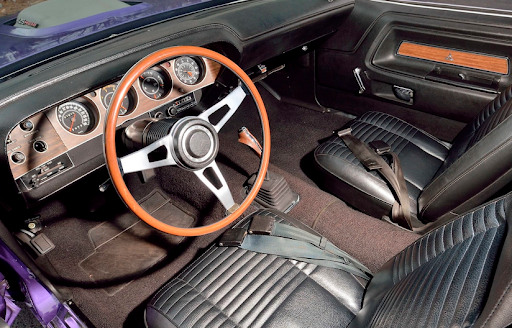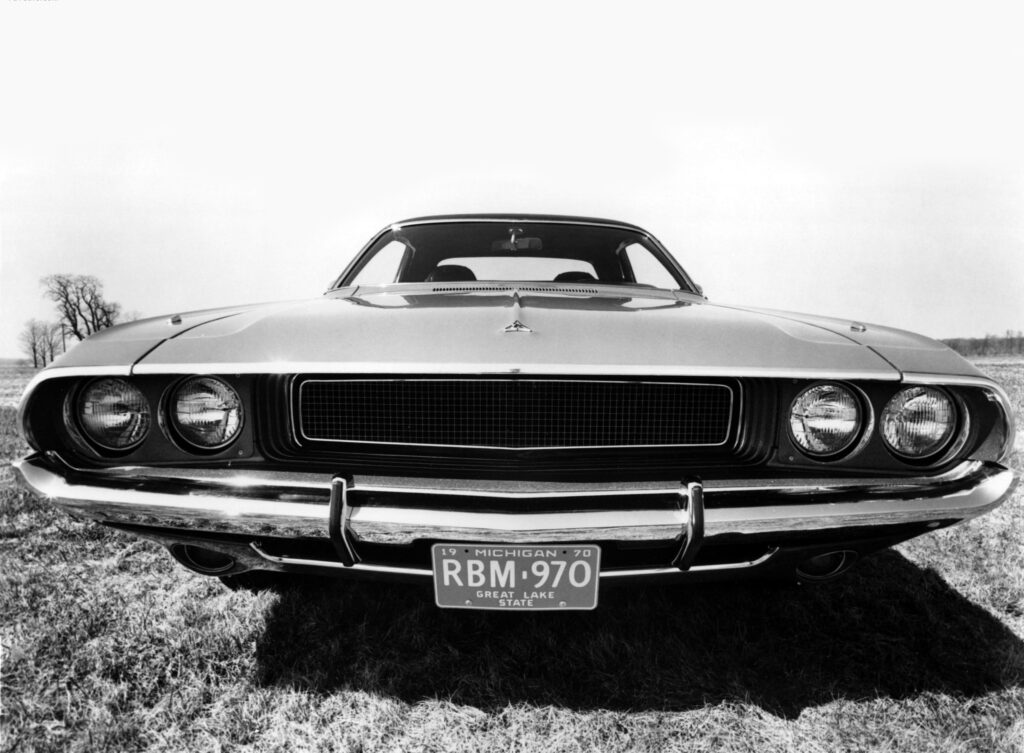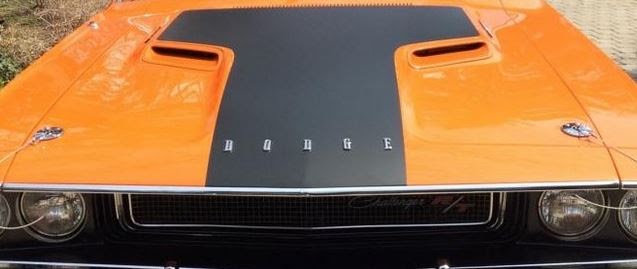For 1970, Plymouth decided to revamp the third-generation Barracuda’s size, style, and look to potentially boost sales and with that, Dodge was to get their own new pony car for the well-selling niche market. The Challenger was born.
Named after a 1959 Chrysler model’s option line, the car was about the same length as the ‘Cuda – at 191.5 inches long. To give some perspective, that is about 3 inches longer than the 2016 Mustang.
| Model | 1970 Dodge Challenger |
| Type | 2-door |
| Names & Trims | Deputy, S/E, T/A, R/T (+Convertible) |
| Engines | 189ci I6, 225ci I6, 318ci V8, 383ci V8, 440ci V8, 440 six-pack, 426ci Hemi |
| Price range | $2,851 – $3,535* |
*Consumer Guide: Encyclopedia of American Cars
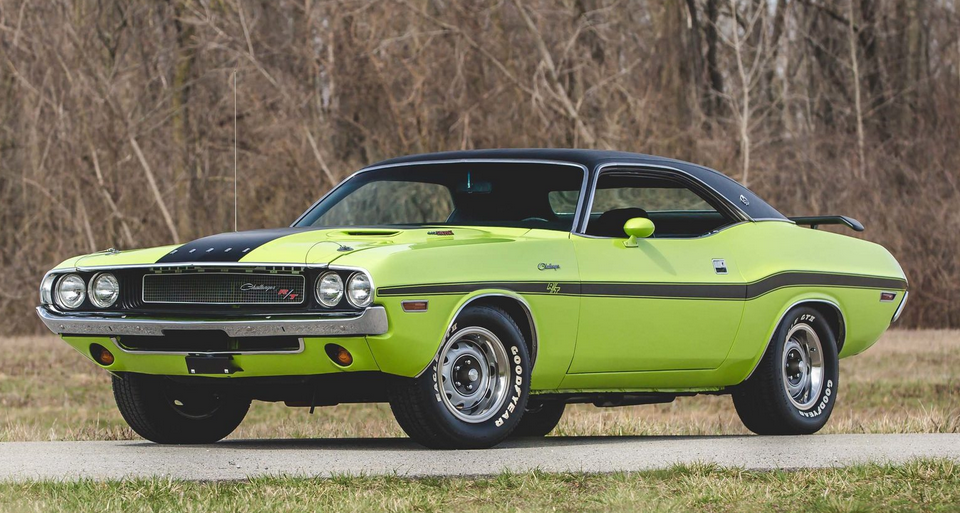
The ‘70 Challenger was created with a style all its own. It started with a dual-headlamp grill in front of a long, well-decorated bonnet. The wheelbase was slightly longer than that of the Barracuda – for better stability, and made it look a bit bigger as well. The rear quarter had just the right amount of arch around the rear tires, and it ended on a simple trunk lid. The rear valance was very dramatic indeed, with large, Charger-like taillights, a large mid-backup light, and optional chrome or black accents to make it all stand out. It is a very sleek-looking car and very much the competitor that Dodge needed.
For 1970, the Challenger was given the color and stripe treatments that Chrysler company had developed for years, and that meant a color-wheel as vast as any car company in the world. It also included stripes and decals that furthered the sporty look. These acrylic paint colors (left) ranged from the sedate (white and blue) to the obscene (Banana, Plum Crazy, and Sublime). The stripe/decals sets were a long list of fun goodies.
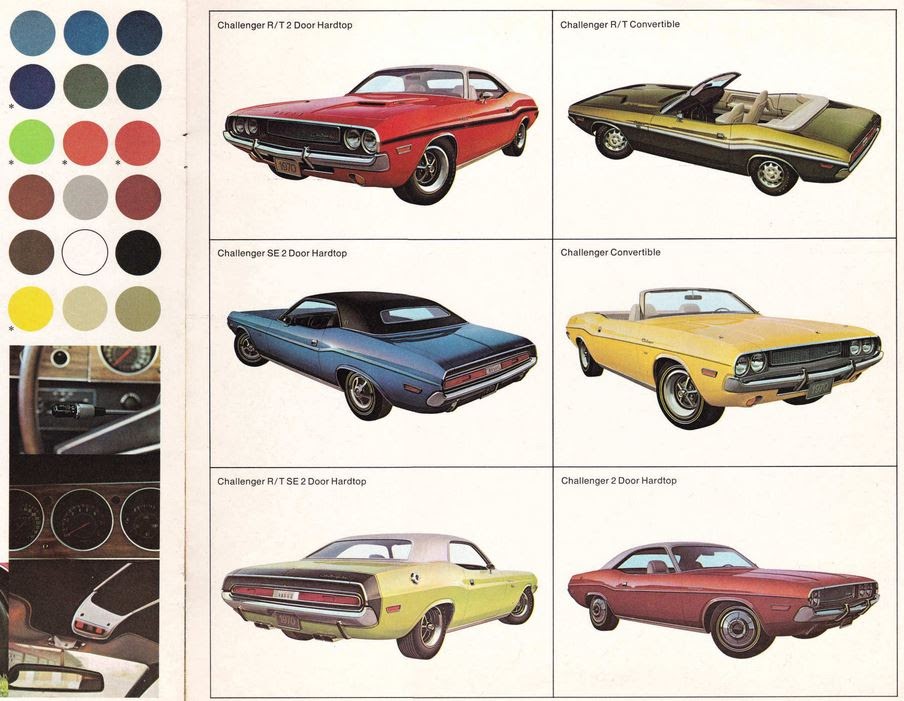
Everything from the large R/T stripes down the side of the car, to the stripes outside the black fiberglass T/A hood, you could make your Challenger stick out as dramatically as you wanted – right from the factory! That said, you could also make a Challenger that was as stylish and sedate as any other model. The Vinyl top and 14” hubs would give the car a more formal and “handsome” look, and though it wouldn’t shock the neighbors like a Hemi Orange R/T would, it would definitely make them take notice.
Available 1970 Challenger Models
1970 Challenger Deputy
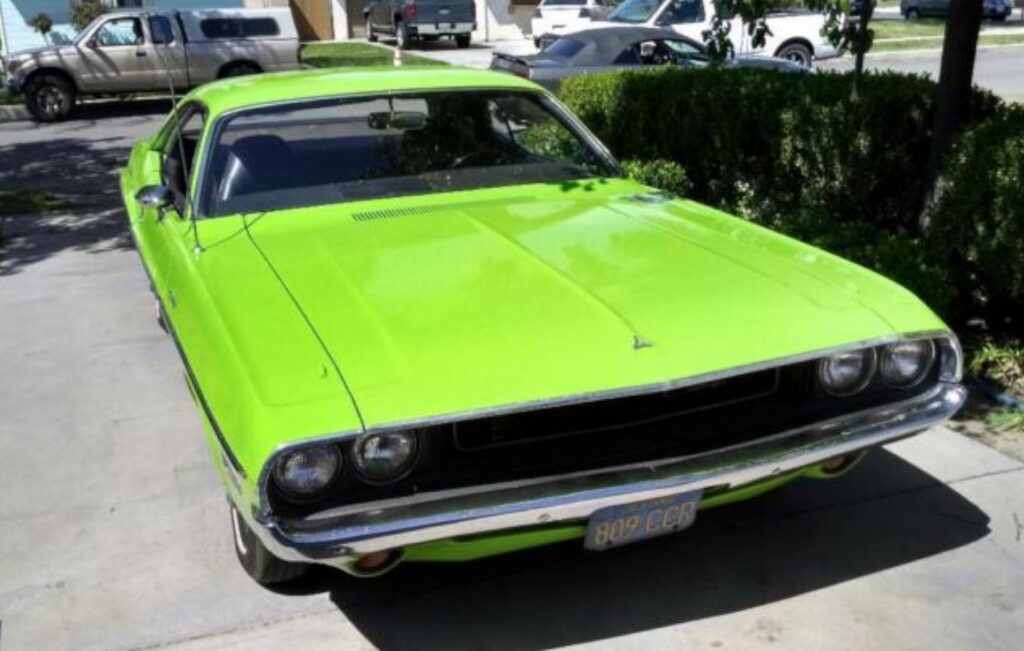
The opening model was referred to as the Deputy. This basic of Challengers still had everything the consumer needed. You would get fixed rear quarter windows, all-vinyl bucket seats, 198ci I6, armrests, ashtrays, and 3-speed manual floor transmission. You could optionally get white sidewall tires, air conditioning, rear-window defogger, and a 383ci V8 with 4-barrel. There was a lot more to be had, but this was the absolute base model, so it was more for the tight budget than one of opulence.
Read more about the 1970 Dodge Challenger Deputy.
1970 Challenger SE

The next level of Challenger resided with the Challenger SE or Special Edition. This was a more formal version of the pony car and included appointments like vinyl roof covering, formal roof styling, overhead console, and genuine leather or vinyl seats. The SE allowed for all engine possibilities as well, so you could ultimately order a 426 Hemi with your special edition R/T Challenger.
1970 Challenger R/T
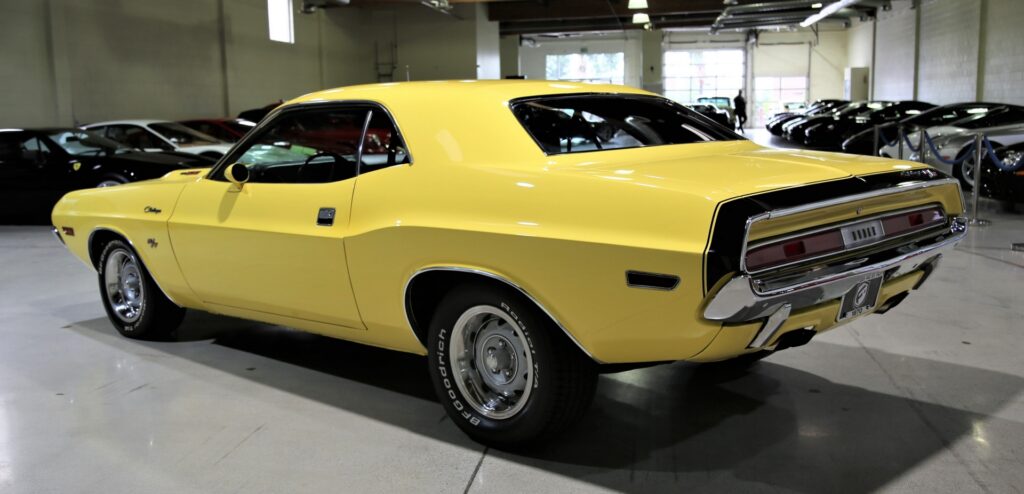
The final rung in the Challenger ladder brings you to the most decorated and highly powered Challenger you could buy – the R/T (road and track). The engines started with the 335hp, 383ci V8. From there you could opt for the 440ci 2 or 4 barrel, the 440ci six-pack (3-2bbl combo), or the amazing 425hp, 426 Hemi. The goodies didn’t stop there.
You got a rally instrument cluster (with tach and 150mph speedometer), 14” white-letter tires, intermittent wipers, heavy-duty brakes, and a stripe kit of your choice – full-length tape stripe, thin dual paint stripe, or bumblebee stripes.
On top of all of this, you could also opt for a 4-speed manual with pistol-grip shifter. These R/Ts were at the top of the Challenger food chain and brought the best of the model’s styling and performance to the forefront.
1970 Challenger T/A

The T/A (Trans Am) was a design made for the Trans Am racing series and was never raced. They were race optioned with 440hp, 305ci engines with a single 4-barrel. So, what did the regular customer get?
Well, you would get Chrysler’s 340 Wedge with a six-pack option and 290 (underrated) horsepower. You’d get a fiberglass hood with ram-air scoop that was painted semi-gloss black; side T/A stripes that ran from the rear pillar to the light housing in front; megaphone tipped, low restriction, side exhaust; and the biggest tires the company offered.
These cars also had a blackened rear tail fin, optional vinyl roof (pictured), positraction limited-slip differential, front chin spoiler, and either a 3-speed Torqueflight or Hurst 4-speed transmission. With low to mid 14sec quarter miles, these were one of the most potent small blocks you could buy in the muscle car era.
Read more about the 1970 Challenger T/A.
1970 Challenger Convertible
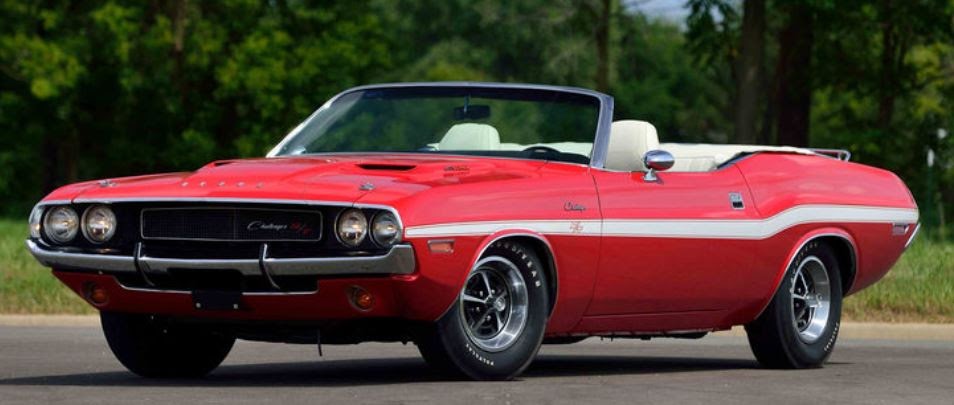
Like its Barracuda stablemate, the Challenger also came in Convertible form. With a black or white vinyl top, you were able to transform whichever of the above (save T/A version) models you purchased into a sunny-day cruiser.
With almost every tasty option listed above, you could have the fun time grocery-getter or the brutal-engined racer that would deafen you when the top was down. Either way, the convertible version was one of the more attractive ‘70s era cars and is one that just cannot be ignored.
1970 Dodge Challenger Specifications, Options, & Interior
Physical Dimensions
The 1970 Dodge Challenger’s physical dimensions:
- Length: 191.5 inches
- Width: 76.5 inches
- Height: 51 inches
Interior
The Challenger’s interior look was one that was familiar for anyone who had driven a Dodge/Plymouth product in the past couple of years. The vinyl or leather bucket seats were tall and shapely (no bench option).
There was an optional center console or you could have your 4-speed on the floor. There were 3 steering wheel options – 2 sporty and one with the classic horn ring. The dash either sported the basic set of gauges or the performance ones with the taller numbered speedometer and tach.
Challengers were closer to a 2+2 than a true four-seater, but it did carry 4 passengers with appropriate seatbelts. All but the Deputy had full open windows as well for the best sport look and airflow through the vehicle.
Sunroofs were also an option on all Challengers save the SE – because of the standard vinyl roof. Though the differences between the ‘Cuda and Challenger were subtle, the view from the driver seat and the outward look was very different.
Hoods
Challenger hoods, like many muscle cars of the era, were available in many varieties. The standard hood would be rather plain with a couple of indentations to take away front the completely flat look. It was good-looking but definitely plain.
The one pictured here is an orange R/T hood and is potentially the one you’d see the most on performance Challengers. With this hood, there are 2 vent openings and potentially the striped look here. Either way, it was a much more bold statement. The next hood is the most intense and it was the “shaker” hood.
Referring to the air cleaner that would come up through the hood, the shaker was so named because it would move and vibrate with the engine’s movement. It would shake slightly normally, but when you tapped the throttle, you could actually watch the motor/air-cleaner flinch abruptly because of the slight movement of the mounts on the engine. Without something holding the block to the car, the engine would likely twist itself out on its own!
Photo Credit: www.rodsclassics.com
The last hood is the rarest – the T/A. This black fiberglass hood was added for performance. Lighter than the standard hoods, the ram-air would also take in air and feed it directly to the carb. Only 2700 T/As were made and fewer still run and drive, so they are the most exclusive you’ll find.
Door Mirrors
1970 Challengers came with a chrome manually controlled mirror mounted on the driver’s door. Optional was a chrome or body-colored remote-controlled “racing” mirror. A matching right side “racing” mirror was available but this was not remotely controlled.
Vinyl Tops
All two-door hardtops could be ordered with a vinyl roof. Colour choices were black, white, green or Gator Grain which was a bit like alligator skin. The Challenger Deputy used a brighter white top than the other models. Because of the modifications around the rear window, the S.E. could not be ordered without one. The position of the two seams that run the length of the roof was different on the SE version.
Power Sunroof
This was a very rare option (code M51) and was available on all hardtops except the S.E. A standard roof was cut to fit the sunroof and the patchwork hidden under a vinyl top. It was opened with a switch or by hand when the ignition was switched off.
Options
The 1970 Challenger was available with numerous options, ranging from small quality of life items (read window defroster) to major features, such as a power sunroof or the 340 performance package. Read more about the 1970 Dodge Challenger options available for new builds.
Optional Axle Packages
Performance Axle Package (A36)
Available on cars with 4bbl or multiple carburetors. Included 3.55:1 axle gears with Sure Grip in a 8.75 inch axle, heavy-duty cooling and heavy-duty suspension.
High-Performance Axle Package (A31)
Available on 340 or 383 4bbl cars. Includes 3.91 axle gears with Sure Grip, max cool radiator with seven-blade fan, and HD suspension.
Super Performance Axle Package (A32)
Available on the 440 and 426 powered cars with automatic transmission. Included 4:10 geared Dana 9.75inch axle with Sure Grip, seven-blade fan, and max cool radiator. N/A with air-conditioning.
Track Pack (A33)
Available on 440 and mandatory on 426 powered cars with 4-speed manual transmission. Included 3.54 gears with Sure Grip in a Dana 9.75 inch axle, seven-blade fan, max cool radiator, and a dual point distributor.
Super Track Pack (A34)
Same as Track Pack but with 4.10 gears and power front disc brakes.
1970 Challenger Wheels & Tires
The wheel studs on the driver’s side of the car were left-hand thread in 1970 only. The T/A came with larger G60 tires on the back wheels (E60s on the front) and more rear leaf spring camber to give a bit of stance and also a bit of clearance for the side exit exhaust on that model.
Standard Steel Wheels
These were painted body colour with “dog dish hubcaps”. Wheels on cars with full size wheel covers were painted black. The six cylinder and 318 V8 models used 14 X 5 inch wheels. Big block cars came with 14 X 6 inch wheels with 15 X 7 optional. The 340 T/A and 426 hemi cars came with the plain steel 15 X 7 size as standard but too many “restorers” have replaced them with Rallye wheels over the years.

A 15X7 steel wheel on a T/A fitted with the “dog dish” type hub cap and a trim ring


A simulated wire (W15), deep dish (W13), or deluxe (W11) wheel cover could be found on most JH Challengers with 14″ wheels
Styled Wheels
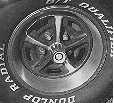
The Chrome Road wheel (W23) aka the “Magnum 500” five spoke style was available in the 14 X 5.5 size only on ’70-’71 Challengers.
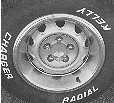
Slotted Rallye wheels (W21) were optional in either 14 X 5.5 or 15 X 7 inch sizes. The trim ring on the Rallye wheel was polished for 1970 only and the centre was silver for 1970 only.
| Size | Type | Part No. |
| 14 X 5.0 | Painted | 3420976 |
| 14 X 5.5 | Painted | 3420977 |
| 14 X 5.5 | Spare | 2944395 |
| 14 X 5.5 | Rallye | 2944252 |
| 14 X 5.5 | Chrome Road | 2944474 |
| 14 X 6.0 | Painted | 3420978 |
| 15 X 7.0 | Painted | 2944450 |
| 15 X 7.0 | Rallye | 2944390 |
If your car had a 6 cylinder engine or a two-barrel carb. then you could not order the 15 X 7 size.
| Engine | Standard | Optional | Recommended Brand |
| 225/318/383 | E78 X 14 | F70 X 14* | Goodyear |
| 340 | E60 X 15 | NONE | Goodyear Polyglas GT |
* V8s only. HD suspension and brakes required.
| Engine | Standard | Optional | Recommended Brand |
| 340+6 (Front) | E60 X 15 | NONE | Goodyear Polyglas GT |
| 340+6 (Rear) | G60 X 15 | NONE | Goodyear Polyglas GT |
| Engine | Standard | Optional | Recommended Brand |
| 383/440 | F70 X 14 | E60 X 15** | Goodyear Polyglas GT |
| 426 Hemi | E60 X 15 | NONE | Goodyear Polyglas GT |
** N/A convertible w/440 engine. N/A w/trailer towing package.
1970 Challenger Chassis & Brakes
The Challenger has a 110 inch wheelbase and a track width of 59.7 inches (F) / 60.7 inches (R). Weight is typically over 3,800 lbs. The car features traditional Chrysler unit-body engineering such as the torsion bar front suspension and independent lateral, non-parallel control arms with an anti-roll bar as standard on the performance (R/T) cars. The rear suspension consists of a live axle on asymmetrical semi-elliptical leaf springs. A rear anti-roll bar was optional.
Drum brakes were standard and measured 10 X 2.5 inches front and rear or 11 X 3 front and 11 X 2.5 rear on the R/T. Optional front brakes were 10.75 inch vented discs with single piston, floating, pin type callipers. These discs were of a two piece design which tended to warp with heat under (very) heavy use but returned to normal after cooling. This problem was not put right until the start of the 1973 model year. Where front disc brakes were fitted the rear drum size was 10 X 2.5.
1970 Dodge Challenger Engines
1970 “Standard” Engine Specifications
| Displacement/
Cylinders |
198 ci I6 | 225 ci I6 | 318 ci V8 | 340 ci V8 | 383 ci V8 |
| Bore & Stroke (in.) | 3.4×3.64 | 3.4×4.12 | 3.91×3.31 | 4.04×3.31 | 4.25×3.38 |
| Carburator | 1bbl | 1bbl | 2bbl | 4bbl | 2bbl |
| Compression | 8:4:1 | 8:4:1 | 8:8:1 | 8:8:1 | 8:7:1 |
| Air Cleaner | Single | Single | Single | Dual | Single |
| Exhaust System | Single | Single | Single | Dual | Single |
| Crankcase | 3¼ quarts – 4 quarts when replacing oil filter on all engines except the 440 and 426 when it is 5 and 6 respectively.
Closed crankcase ventilation with cleaner air system standard on all engines. |
||||
| Coolant | 10.8 qts. | 10.8 qts. | 13.3 qts. | 12.5 qts | 12.1 qts |
| Horsepower | 125 @ 4400 | 145 @ 4000 | 230 @ 4400 | 275 @ 5000 | 290 @ 4400 |
| Torque | 215 @ 2400 | 320 @ 2000 | 340 @ 3200 | 390 @ 2800 | |
| Fuel Recommended | Regular | Regular | Regular | Premium | Regular |
1970 High-Performance Engine Specifications
| Displacement/
Cylinders |
383 ci V8 | 440 ci V8 | 440 ci SixPack | 426 ci V8 |
| Bore & Stroke (in.) | 4.25×3.38 | 4.32×3.75 | 4.32×3.75 | 4.25×3.75 |
| Carburator | 4bbl | 4bbl | 3x2bbl | 2x4bbl |
| Compression | 9:5:1 | 9:7:1 | 10:5:1 | 10:25:1 |
| Air Cleaner | Double | Double | Unsilenced | Unsilenced |
| Exhaust System | Dual | Dual | Dual | Dual |
| Crankcase | 3¼ quarts – 4 quarts when replacing oil filter on all engines except the 440 and 426 when it is 5 and 6 respectively.
Closed crankcase ventilation with cleaner air system standard on all engines. |
|||
| Coolant | 15 qts. | 16 qts. | 16 qts. | 17 qts. |
| Horsepower | 335 @ 5200 | 375 @ 4600 | 390 @ 4700 | 425 @ 5000 |
| Torque | 425 @ 3400 | 480 @ 3200 | 490 @ 3200 | 490 @ 4000 |
| Fuel Recommended | premium | premium | premium | premium |
In the Mopar world, the engines make the value of the vehicle. You’ll most likely never find a 383ci Challenger that even remotely out-prices a Hemi. That said, all of the engines for 1970 were good running motors.
- First on the list is the 198ci I6. This motor was very underpowered – even for the smaller Challenger – but would still get the job done.
- Next was the juggernaut 225ci I6. This motor – by most mechanic’s standards – was near indestructible. There are stories of motors lasting 200k miles, running without oil, working with 5 cylinders, and plain out-running other engines. It is Chrysler’s best early motor and one you’ll find in cars spanning FORTY years… even the Hemi can’t say that.
- The next up is the 318ci V8. Used in most mid-level Mopars, the 5.2-liter motor was a good workhorse. Also fairly strong, this motor was used in almost everything – from Jeeps to police cars.
- For extra performance, the average customer could get some serious horsepower installed right from the factory. The lowest of the aggressive engines was the 383ci V8. These big-blocks were strewn through ‘60s and early ‘70s Mopar muscle. The 335hp made for brisk acceleration in most of their cars and would run the Challenger in the lower 15s through the quarter-mile. This wouldn’t be king of the dragstrip by any means, but it would definitely not be gentle on the senses.
- The 440ci V8 in either single 4-barrel or six-pack form changed the Challenger from 383ci-quick to 440ci-blisteringly quick. The 375 or 390 hp you’d get from either of these engines would make the car far less tame and would scare the pants off someone used to the I6 engines. At this point, the quarter-mile would dip into the high 13 second times.
- The last in the line-up is the king… the 426 Hemi. Named for the hemispherical cylinder heads in the motor, the 7.0Liter big-block was rated at 425hp (as much as a Chrysler product could have from a showroom) and almost 500lb-ft of torque.
- These engines were amazing to hear, amazing to drive, and amazing to race. Lower-to-mid 13 second quarter mile passes were common in cars with these engines. They are also THE most coveted engines to reside in Mopar cars and typically carry price tags far over the comparably-powered 440. There is a lot of discussion in the Mopar circuit – both at shows and online – about which is better/faster.
- The consensus seems to point to the 440-4barrel being the easiest to live with, the 440 six-pack being the quickest to 60mph (but tougher to tune – with the 3 carbs), and the Hemi being the quickest through the quarter – with the higher top end.
No matter what the opinion polls say, there are two things that are unarguable:
- The hemi is the most coveted (both with likes and pricing), and
- ANY of the above three performance-V8 engines will give you the thrill you need.
1970 Challenger Transmissions
The Challenger line-up would give a few options for your purchase depending on your needs for everyday driving or performance.
- The base transmission would be the 3-speed automatic in column or console shifting styles or a 3-speed manual floor shift. This was available in A903/904 for the lower engines and A833 for the engines bigger than the 318ci.
- The next style for the performance engines would be the 727 Torqueflight automatic. This was used in anything above the 340ci engine and was a very resilient transmission.
- Lastly would be the 4-speed that would come with a pistol-grip shifter (a wooden top in the shape of a hand-gun grip). These were optioned with regular and limited-slip differentials.
1970 Challenger Production Numbers
The 1970 Challenger was the best-selling Challenger on the gen-1 Challengers. They sold the following units:*Consumer Guide: Encyclopedia of American CarsThe Challenger had an outstanding year – outselling its running-mate Barracuda 3-to-1. It would be the last time this Challenger would sell more than 30,000 cars. See more on 1970 Dodge Challenger production numbers.
| Challenger Hardtop Coupe | 53,337 |
| Challenger Convertible Coupe | 3,173 |
| Challenger S.E. Coupe | 6,584 |
| Challenger R/T Hardtop Coupe (inc T/A) | 14,889 |
| Challenger Convertible Coupe | 1,070 |
| Challenger S.E. Hardtop Coupe | 3,979 |
| Total Production Numbers | 83,032* |







